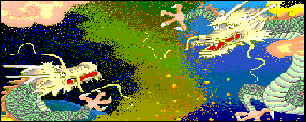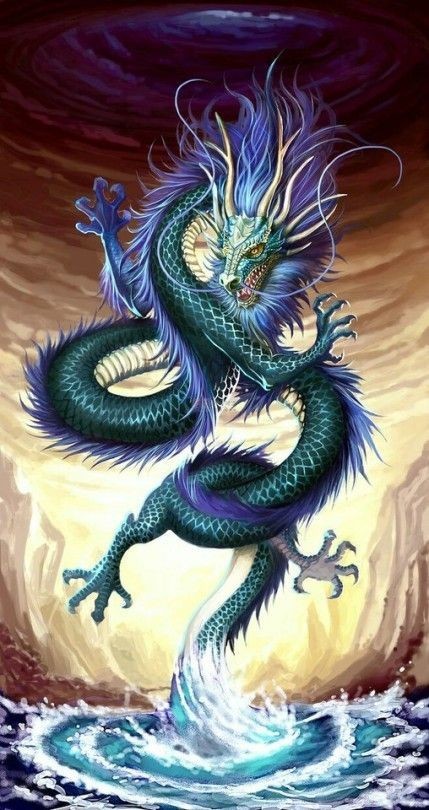DRAGON, Oriental

DRAGON, Oriental

|
|
|
|
|
|
|
|
|
|
|
|
Oriental dragons are related
to, though different in some respects
from, other dragons,
and individuals vary as to colour, being
possibly white,
red,
yellow,
blue,
green
or
black. Their powers vary with their
type, and each sort of dragon
is treated individually hereafter. General information
and common characteristics
are included in this preamble.

As with other dragons, oriental
dragons have three general size
categories (small,
average, and huge) according
to the size typical of
each. This categorisation
is determined by rolling d8; 1-2=small; 3-7=average, 8=huge.
This size determination
also indicates the # of HD a dragon has.
Oriental dragons, like other
dragons, pass through eight ages in their lives.
These growth stages are:
| - | - | - | - |
| 1. | Very young | 1-5 years | 1 hit point per die |
| 2. | Young | 6-15 years | 2 hit point per die |
| 3. | Sub-adult | 16-25 years | 3 hit point per die |
| 4. | Young adult | 26-50 years | 4 hit point per die |
| 5. | Adult | 51-100 years | 5 hit point per die |
| 6. | Old | 101-200 years | 6 hit point per die |
| 7. | Very old | 201-400 years | 7 hit point per die |
| 8. | Ancient | 401+ years | 8 hit point per die |
To determine the age (and
thus the # of HP per die a
dragon has) simply roll
d8, the # rolled indicating
the age as shown above.
Oriental dragons never sleep
and furthermore they have continual ESP (as the spell)
at a range in feet =equal=
to 5 times the age-level of the
dragon. All except yu
lung can polymorph
into human
form and back
at will. They can also become
invisible
and visible at will, though they
always become visible when
attacking. Only yu lung can be subdued.
Scaly
Command: Certain types have the scaly command power. No scaly
unintelligent
creature which lives in
the water (chiefly fishes and reptiles) will ever
willingly attack an oriental
dragon with the power. In addition, such
a dragon can, once per day,
control for a half-mile radius the number
of unintelligent scaly cretures
which live in the water which is
specified for each class.
This command lasts 2-12 turns and cannot
be dispelled. Creatures
already under the scaly command power
of one dragon cannot fall
under the power of another.
There is no saving throw
against scaly command.
Water Fire: Certain
other types have the power of water fire.
This unearthly stuff may
be created by any oriental dragon with the power whenever it is
under or touching water,
and may be dispelled by the creator at any time.
Water fire surrounds
the body like the flame of a <Type VI> demon and does damage
to
anyone touching it at the
amount specified for each
type. All oriental dragons
are themselves immune to water fire. The
effect will disappear for
20-120 rounds after being contacted by real
or magical 'heat' fire,
and cannot be recreated until the end of that period.
Dragon Fear: Like
other dragons, oriental dragons (except for yu lung)
develop the
power to panic enemies as
they mature. At adult age and older they
radiate a powerful aura
which causes a fear reaction, when a dragon
flies overhead or charges,
as follows:
1. All
creatures under 1 HD, as well as non-carnivorous creatures
of any
sort which are not trained for warfare or basically not
fearless
or aggressive will FLEE in panic. Such rout will be made at
fastest
SPEED possible an it will continue for 4-24 turns.
2. Creatures
with fewer than 3 HD must save vs. magic or be
paralysed
with fear (50%) or panic as above (50%).
3. Creatures with 3 to 5 HD will fight at a penalty of -1 on their 'to hit' roll unless they save vs. magic.
4. Creatures with 6 or more HD automatically disregard the aura effect.
5. The
aura of adult, old and very old dragons is not as
powerful as that of ancient dragons,
so saving
rolls applicable to their auras at +5, +3 and +1, respectively.
Thus,
a 2nd level fighter, normally having to score 16 (75%) or better to save
against magic (the dragon's aura in this case),
would
gain a bonus of 5 on his saving roll vs. an
adult dragon's aura;
so any score of 11 or more would save him from panic.
Encountering Multiple
Dragons: If two or more dragons are encountered outside their lair
it will be a mated pair if two are
encountered and sub-adults
if three or more are encountered. If two
or more are encountered
in their lair it will be a mated pair -- with
their young if applicable.
Mated pairs are always 5th-8th age
categories. Any young in
this case are eggs (10%) or very young (90%). If
young are attacked, both
adults will automatically breathe and then
melee to bite, gaining a
bonus of +2 to hit and +1/+3 in
clawing/biting damage. If
either of the mated pair is attacked the
other oriental dragon will
rush to its defence, gaining the ferocity
bonuses stated above, unless
it is attacked simultaneously.
Treasure: Very
young oriental dragons will usu. have no treasure,
but there is a 10% chance
that they will have one-quarter the possible listed treasure.
Young oriental dragons
have a 25% chance for one-quarter of the listed treasure.
Sub-adults have a
50% chance for one-half the possible listed treasure.
Young adults, adults
and old dragons have normal treasure.
Very old and ancient
dragons
are 50% and 75% likely to have 150% and 200% respectively of the listed
treasure.
Oriental Dragon Saving
Throws: When an oriental dragon attains 5 or more HP per die,
its save is calculated by
dividing its total HP by 4, thus giving a higher number of HD than it actually
has.
This reflects the magic
resistance && general toughness of the creature.
Conversely, even a very
young oriental dragon gains the benefit of the actual number of its
HD,
even though the HP/die are
but 1 each, for determining scores required.
This reflects the same nature
of dragonkind, i.e. resistance & toughness.
by
David Sweet
DRAGONS, ORIENTAL
(Additions)
Most oriental dragons are officials in
the Celestial Bureaucracy. Each type has
been charged with some
aspect of government, as listed below.
Once per year each dragon must go to the Celestial Palace and file a
report of the previous year's activities
and events. This report is examined by the appropriate censors and
rewards and punishments are handed out
accordingly. It is not uncommon for a corrupt or incompetent dragon
to be removed from his position and replaced
by a new appointee. Such changes in the Celestial Bureaucracy
are made known to humans by dreams which
announce the new official and his arrival date. Knowing this, the
humans prepare a ceremonial procession
and banquet of offerings to please and curry favor with the new
dragon.
| Dragon | Position |
| Li Lung | Control of the energies of the earth |
| Lung Wang | Guardians of sea creatures, aide to the Sea Lords |
| Pan Lung | Guardians of hidden places |
| Shen Lung | Aides to the Chiang Lung |
| T'ien Lung | Masters of weather (except rain) |
| Chiang Lung | Guardians of rivers and lakes, bringers of rain |
| Tun Mi Lung | Dispenser of ocean storms |
| Yu lung | The yu lung does not hold an official
position in the Celestial Bureaucracy
and is not considered to belong to the class of greater dragons.
As such, it receives no offerings and has no cult among the human population. |
In addition to the Oriental dragons listed
in the FF Tome, the following two dragons are
also found in the Orient: <link> <link>

Those that are not truly
proprietary are:
rot grub--based on a common
insect, but not very popular
giant leech--similar to
an LA game blindworm
thoul--a critter never detailed
in and form of the D&D game and which I have included in the monsters
found in the CZ dungeons already
lungs are already covered
as dragons in the LA game, with
I guess I'll work up the
thoul for the LA game critters then ![]()
Cheers,
Gary

As for the best looking
dragons, I must say that I have always thought the Oriental depictions
are tops. Of course, the great interest in drakes arising from the D&D
game has certainly brought to the fore many excellent illustrations of
most imaginative and artistic sort.
Cheers,
Gary
Quote:
Originally Posted by Odnasept
Secondly, what is your stance on the increase in power dragons received upon the release of the 2nd Edition AD&D game? They were always beings of great power, but the non-unique dragons went from being inferior to the most powerful of giants to being able to surpass them and perhaps even Titans as well once they reached the eldest age categories (I persynally almost always supported this change, though my reason is primarily due to an inherent love of dragonkind and ambivalence toward giantkind).

I am much appaled by the
over-emphasis of the prowess of the Occidental dragon.
They were continually slain
by humans, so what is the justification for the power increase?
Nothing but the hubris of
the inept designer.
OTOH, if proper stats were
desired, the Oriental dragons are the ones that need be vastly improved
in their capacities.
This is not to say that I
did not intend to beef up these critters in a revised edition of the AD&D
game.
I was planning to move the
base HD from d8 to d10 or maybe d12, and give them additional attack damage
equal to the number of HD possessed, this in an incrimental scale (intended)
based on the HPs per HD possessed. As i mentined previously, all large
and robust critters were to have gained d12 HD base, HP spread based on
50% of HD + a variable addition above that equal to up to another 50%,
along with damage addition based on HD#. (I have dine this in the camopaign
material I have created for the C&C RPG system.)
In short, I do not believe
that dragins were everm or should be now, the toughest monsters in the
marches, and I will not cave in to pressure to change my mind in that regard.
Quote:
Originally Posted by Griffith
Dragonlake
Hi Gary,
Starting with OD&D (1974), all dragons had a % chance to talk, and all but the white dragons a % chance to use magic.
What was your inspiration for talking and/or magic-using dragons? I'm at a loss to find any European mythological or pre-20th century literary sources for magic-using dragons (aside from the East Asian ones).

Howdy,
Actually, you have the source
of that inspiration, the Oriental treatment of dragons.
It seemed a good idea to
me to enable Occidental dragons to be able to converse and use magic in
order to make them more dangerous and complex.
Christmas best wishes,
Gary
<the image is shenlung.png>
<rename file>
<the ideal is 1 standard
file format for the site>